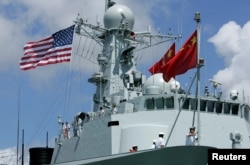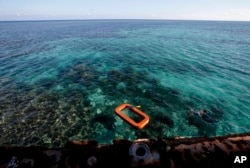ກະຊວງປ້ອງກັນປະເທດຂອງຈີນ ກ່າວໃນວັນພະຫັດມື້ນີ້ວ່າ ການຕັດສິນໃຈຂອງສະຫະ
ລັດ ທີ່ຈະຍົກເລີກການເຊື້ອເຊີນຈີນ ບໍ່ໃຫ້ເຂົ້າຮ່ວມການຊ້ອມລົບ ທາງທະເລລະຫວ່າງ
ປະເທດຄັ້ງສຳຄັນນັ້ນ ແມ່ນ “ບໍ່ສ້າງສັນ.”
ຖະແຫຼງການຂອງກະຊວງປ້ອງກັນປະເທດ ກ່າວວ່າ ເຖິງແມ່ນໄດ້ມີການຕັດສິນໃຈດັ່ງ
ກ່າວກໍຕາມ ແຕ່ຈີນກໍຍັງຈະສືບຕໍ່ ເອົາບົດບາດທີ່ສຳຄັນ ໃນການ “ຮັກສາສັນຕິພາບ ແລະສະຖຽນລະພາບ ຢູ່ໃນຂົງເຂດເອເຊຍ-ປາຊີຟິກ.”
ສະຫະລັດໄດ້ປະກາດກ່ຽວກັບການເຄື່ອນໄຫວດັ່ງກ່າວໃນວັນພຸດວານນີ້ ໂດຍກ່າວວ່າ “ການປະພຶດທີ່ສ້າງຄວາມບໍ່ທຸ່ນທ່ຽງ” ຂອງປັກກິ່ງ ຢູ່ໃນທະເລຈີນໃຕ້ແມ່ນບໍ່ສອດຄ່ອງ
ກັບຫຼັກການຂອງການຊ້ອມລົບ ພາຍໃຕ້ການນຳພາຂອງສະຫະລັດ.
ພັນໂທຄຣິສໂຕເຟີ ໂລແກນ ໂຄສົກຂອງທຳນຽບຫ້າແຈ ກ່າວຢູ່ຖະແຫຼງການວ່າ
“ການສືບຕໍ່ເສີມສ້າງກຳລັງທະຫານຂອງຈີນໃນເຂດທີ່ມີການຂັດແຍ້ງຢູ່ທະເລຈີນໃຕ້
ມີແຕ່ຈະກໍ່ໃຫ້ເກີດຄວາມເຄັ່ງຕຶງແລະຄວາມບໍ່ທຸ່ນທ່ຽງຢູ່ໃນຂົງເຂດ.”
ຖະແຫຼງການກ່າວຕໍ່ໄປວ່າ ການຍົກເລີກໃນການເຊື້ອເຊີນຈີນ ບໍ່ໃຫ້ເຂົ້າຮ່ວມການຊ້ອມ
ລົບ ຣິມແພັກ (RIMPAC) ປີ 2018 ແມ່ນເປັນພຽງການຕອບໂຕ້ໃນຂັ້ນຕົ້ນ ຕໍ່ກິດຈະກຳ
ຂອງປັກກິ່ງໃນທະເລຈີນໃຕ້. ຖະແຫຼງການ ບໍ່ໄດ້ລະບຸຢ່າງເຈາະຈົງວ່າ ບາດກ້າວອື່ນໆ
ທີ່ຈະເອົານັ້ນມີຫຍັງແດ່.
ທ່ານຫວັງ ຢິ ລັດຖະມົນຕີກະຊວງການຕ່າງປະເທດຈີນກ່າວວ່າ ກິດຈະການຂອງຈີນ
ຢູ່ທະເລຈີນໃຕ້ ແມ່ນເພື່ອປ້ອງກັນໂຕ ແລະກໍຍັງນ້ອຍກວ່າທີ່ສະຫະລັດໄດ້ກະທຳຢູ່ທີ່
ເກາະຮາວາຍແລະເກາະກວມ.
ທ່ານກ່າວຢູ່ໃນກອງປະຊຸມຖະແຫຼງຂ່າວຮ່ວມກັບລັດຖະມົນຕີການຕ່າງປະເທດສະຫະ
ລັດ ທ່ານໄມຄ໌ ພອມພີໂອ ວ່າ “ພວກເຮົາຫວັງວ່າ ສະຫະລັດ ຈະປ່ຽນຄວາມນຶກຄິດ
ໃນທາງລົບແບບນັ້ນ.”
ນັບແຕ່ປີ 2014 ເປັນຕົ້ນມາ ຈີນໄດ້ເຂົ້າຮ່ວມ ການຊ້ອມລົບ RIMPAC ຊຶ່ງເປັນການ
ຊ້ອມລົບທາງທະເລ ລະຫວ່າງປະເທດ ທີ່ໃຫຍ່ທີ່ສຸດ ແລະຈັດຂຶ້ນໃນທຸກໆ 2 ປີທີ່ລັດ
ຮາວາຍ. ມັນເປັນການສະທ້ອນໃຫ້ເຫັນ ເຖິງການຂະຫຍາຍ ຄວາມສຳພັນທາງທະຫານ ລະຫວ່າງສະຫະລັດກັບຈີນ ທັງໆທີ່ໄດ້ເກີດຄວາມເຄັ່ງຕຶງ ຍ້ອນການສ້າງເກາະທຽມ
ຂອງຈີນຢູ່ທະເລຈີນໃຕ້ ຊຶ່ງບາງເກາະດອນໃນຈຳນວນດັ່ງກ່າວແມ່ນມີການຕັ້ງຄ້າຍ
ທະຫານໃສ່.
ອ່ານຂ່າວນີ້ເພີ່ມຕື່ມເປັນພາສາອັງກິດ
Largest international maritime drill
Since 2014, China has taken part in RIMPAC, the world’s largest international maritime drill, which is held every two years in Hawaii. It’s a reflection of expanding U.S.-China military ties, despite tensions over Beijing’s construction of man-made islands in the South China Sea, some of which have been militarized.
"We have strong evidence that China has deployed anti-ship missiles, surface-to-air missile (SAM) systems, and electronic jammers to contested features in the Spratly Islands region of the South China Sea. China's landing bomber aircraft at Woody Island has also raised tensions," the Pentagon statement said.
"We have called on China to remove the military systems immediately and to reverse course on the militarization of disputed South China Sea features," the statement added. "We believe these recent deployments and the continued militarization of these features is a violation of the promise that (Chinese) President Xi (Jinping) made to the United States and the World not to militarize the Spratly Islands."
South China Sea
China claims virtually the entire South China Sea, despite overlapping claims by Brunei, Malaysia, Taiwan, the Philippines and Vietnam. The area is rich in fish, oil and natural gas resources. It's also a vital shipping lane. About $5.3 trillion worth of goods moves through the sea every year, according to the U.S. Department of Defense.
U.S. ships and aircraft have conducted regular "freedom of navigation" operations (FONOPS) near some of the Chinese installations. But the Pentagon's decision to boot Beijing from RIMPAC suggests U.S. officials realize the FONOPS were not enough to deter China, says Harry Kazianis, director of Defense Studies at the Center for the National Interest.
"China should never, ever have been invited to RIMPAC. Period," Kazianis said. "Considering their aggressive approach to dominate the Asia-Pacific region, turn the South China Sea into their own personal lake, as well as diminish America's position in the region, this move on the Trump administration's part makes sense."
The decision comes at a particularly sensitive moment in U.S.-China relations. Washington and Beijing are engaged in negotiations aimed at averting a trade war. Those talks have been complicated by plans for a nuclear summit with North Korea, a major ally of Beijing.






